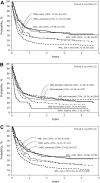Allogeneic transplantation for therapy-related myelodysplastic syndrome and acute myeloid leukemia
- PMID: 20032503
- PMCID: PMC2832815
- DOI: 10.1182/blood-2009-10-249128
Allogeneic transplantation for therapy-related myelodysplastic syndrome and acute myeloid leukemia
Abstract
Therapy-related myelodysplastic syndromes (t-MDSs) and acute myeloid leukemia (t-AML) have a poor prognosis with conventional therapy. Encouraging results are reported after allogeneic transplantation. We analyzed outcomes in 868 persons with t-AML (n = 545) or t-MDS (n = 323) receiving allogeneic transplants from 1990 to 2004. A myeloablative regimen was used for conditioning in 77%. Treatment-related mortality (TRM) and relapse were 41% (95% confidence interval [CI], 38-44) and 27% (24-30) at 1 year and 48% (44-51) and 31% (28-34) at 5 years, respectively. Disease-free (DFS) and overall survival (OS) were 32% (95% CI, 29-36) and 37% (34-41) at 1 year and 21% (18-24) and 22% (19-26) at 5 years, respectively. In multivariate analysis, 4 risk factors had adverse impacts on DFS and OS: (1) age older than 35 years; (2) poor-risk cytogenetics; (3) t-AML not in remission or advanced t-MDS; and (4) donor other than an HLA-identical sibling or a partially or well-matched unrelated donor. Five-year survival for subjects with none, 1, 2, 3, or 4 of these risk factors was 50% (95% CI, 38-61), 26% (20-31), 21% (16-26), 10% (5-15), and 4% (0-16), respectively (P < .001). These data permit a more precise prediction of outcome and identify subjects most likely to benefit from allogeneic transplantation.
Figures




Comment in
-
Safety and efficacy of CPX-351 in younger patients (<60 years old) with secondary acute myeloid leukemia.Blood. 2023 Mar 23;141(12):1489-1493. doi: 10.1182/blood.2022016678. Blood. 2023. PMID: 36493344 No abstract available.
Similar articles
-
Treosulfan, fludarabine, and 2-Gy total body irradiation followed by allogeneic hematopoietic cell transplantation in patients with myelodysplastic syndrome and acute myeloid leukemia.Biol Blood Marrow Transplant. 2014 Apr;20(4):549-55. doi: 10.1016/j.bbmt.2014.01.009. Epub 2014 Jan 16. Biol Blood Marrow Transplant. 2014. PMID: 24440648 Free PMC article. Clinical Trial.
-
Sustained remissions of high-risk acute myeloid leukemia and myelodysplastic syndrome after reduced-intensity conditioning allogeneic hematopoietic transplantation: chronic graft-versus-host disease is the strongest factor improving survival.J Clin Oncol. 2008 Feb 1;26(4):577-84. doi: 10.1200/JCO.2007.11.1641. Epub 2007 Dec 17. J Clin Oncol. 2008. PMID: 18086801
-
Post-Transplant Cyclophosphamide Combined with Anti-Thymocyte Globulin as Graft-versus-Host Disease Prophylaxis for Allogeneic Hematopoietic Cell Transplantation in High-Risk Acute Myeloid Leukemia and Myelodysplastic Syndrome.Acta Haematol. 2021;144(1):66-73. doi: 10.1159/000507536. Epub 2020 May 19. Acta Haematol. 2021. PMID: 32428903
-
Outcomes with Allogeneic Hematopoietic Stem Cell Transplantation in Therapy Related Myeloid Neoplasms: A Systematic Review and Meta-Analysis.Clin Lymphoma Myeloma Leuk. 2025 May;25(5):e319-e335. doi: 10.1016/j.clml.2024.12.018. Epub 2025 Jan 7. Clin Lymphoma Myeloma Leuk. 2025. PMID: 39890517
-
Therapy-related myeloid leukemia.Semin Oncol. 2008 Aug;35(4):418-29. doi: 10.1053/j.seminoncol.2008.04.012. Semin Oncol. 2008. PMID: 18692692 Free PMC article. Review.
Cited by
-
[Clinical analysis of 8 cases therapy related leukemia].Zhonghua Xue Ye Xue Za Zhi. 2015 May;36(5):436-8. doi: 10.3760/cma.j.issn.0253-2727.2015.05.019. Zhonghua Xue Ye Xue Za Zhi. 2015. PMID: 26031536 Free PMC article. Chinese. No abstract available.
-
Genetic features and outcomes of allogeneic transplantation in patients with WT1-mutated myeloid neoplasms.Blood Adv. 2024 Feb 13;8(3):562-570. doi: 10.1182/bloodadvances.2023010960. Blood Adv. 2024. PMID: 38011614 Free PMC article. No abstract available.
-
Molecular and genomic landscapes in secondary & therapy related acute myeloid leukemia.Am J Blood Res. 2021 Oct 15;11(5):472-497. eCollection 2021. Am J Blood Res. 2021. PMID: 34824881 Free PMC article. Review.
-
Therapy-related myeloid neoplasms after transcatheter arterial chemoembolization for hepatocellular carcinoma.Blood Res. 2021 Dec 31;56(4):349-353. doi: 10.5045/br.2021.2021197. Blood Res. 2021. PMID: 34916341 Free PMC article. No abstract available.
-
Allogeneic Hematopoietic Stem Cell Transplantation In Therapy-Related Myeloid Neoplasms (t-MN) of the Adult: Monocentric Observational Study and Review of the Literature.Mediterr J Hematol Infect Dis. 2018 Jan 1;10(1):e2018005. doi: 10.4084/MJHID.2018.005. eCollection 2018. Mediterr J Hematol Infect Dis. 2018. PMID: 29326802 Free PMC article.
References
-
- Borthakur G, Estey AE. Therapy-related acute myelogenous leukemia and myelodysplastic syndrome. Curr Oncol Rep. 2007;9(5):373–377. - PubMed
-
- Michels SD, McKenna RW, Arthur DC, Brunning RD. Therapy-related acute myeloid leukemia and myelodysplastic syndrome: a clinical and morphologic study of 65 cases. Blood. 1985;65(6):1364–1372. - PubMed
-
- Miller JS, Arthur DC, Litz CE, Neglia JP, Miller WJ, Weisdorf DJ. Myelodysplastic syndrome after autologous bone marrow transplantation: an additional late complication of curative cancer therapy. Blood. 1994;83(12):3780–3786. - PubMed
-
- Stone RM, Neuberg D, Soiffer R, et al. Myelodysplastic syndrome as a late complication following autologous bone marrow transplantation for non-Hodgkin's lymphoma. J Clin Oncol. 1994;12(12):2535–2542. - PubMed
Publication types
MeSH terms
Grants and funding
LinkOut - more resources
Full Text Sources
Other Literature Sources
Medical
Research Materials
Miscellaneous

